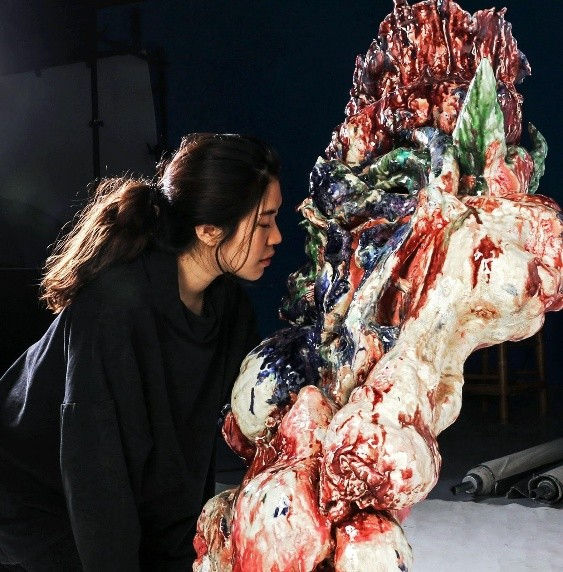The Cripped and Queered Vessel ─ Tsai Jia-Hong Solo Exhibition
- 空間 絕對

- 8月1日
- 讀畢需時 3 分鐘
已更新:8月16日

The Cripped and Queered Vessel ─ Tsai Jia-Hong Solo Exhibition
Duration|2025.08.14 (thu) - 09.21 (sun)
Curator| Lu Wei-Lun
Artist| Tsai Jia-Hong
Venue|Absolute Space for the Arts
Opening|2025.08.17 (sun) 15:00
Forum|2025.08.17 (sun) 15:30
Forum Guest|Lu Wei-Lun, Aluaiy Kaumakan
Illustration & Visual Design | Tsai Jia-Hong
/ Statement /
It is said that the first goddess figurine, which appeared along the banks of the Danube thirty thousand years ago, was a vessel embodying fertility, invocation, yearning, and desire.
Since then, a proliferating lineage of goddess-bodies has emerged across human civilization. We were part of her metamorphosis—one shaped by the demands of patriarchy and the scripting of maternity—that sculpted both canon and abundance.
But beyond the reach of myth, her body is not always divine. Behind yearning and desire lie the cult and the abject—forms cast out by patriarchal civilization and reproductive ideology. A crip lineage surfaces in the history of art. The blood of the goddess lingers here. For the first time, it gives birth to nothing.
Since 2019, Tsai Jia-Hong’s practice has unfolded through illness and trauma. In the process, she has continually reflected on the relationship between life and flesh. Her steady gaze upon death and pain reappears as an obsession with material—giving rise to a decaying aesthetic, a ceramic practice attuned to pathology. Within the canonical mythos, however, the ceramic vessel has long symbolised something else: saturated contours and perfect swellings—metaphors for the maternal body. Tsai turned away early from that heavenly lexicon, stepping instead into the real—into the cripped and the queer.
This exhibition takes the “mother-vessel” as both response and provocation—a symbol shifting from the divine to the body, gesturing toward its lingering ambiguities and spectral traces. Within this crip lineage, these mother-vessels no longer carry the intact meanings once assigned by cultural canons. They frustrate the allegory of the goddess and fracture its logic. Yet in lived experience, crip and queer may well intertwine into another mode of consciousness—one that dismantles the linear temporality of reproductive ideology, loosening the historical bind between the mother-vessel and its utility. In a moment of disorder and unmaking, the crip female body, the pathological womb, begins to take a departure—
although I do not know where it leads, I imagine she will ultimately bid farewell to the enchantment of classicism, to encounter another kind of desire, another kind of compassion.
/ About Artist /

Currently living in Taipei and Kaohsiung. As an art creator and visual designer. How to call potential emotional driving through the process of creation is the path I keep exploring. For ceramics creation, what I repeatedly experiment with is a state of "things coiling around each other." I believe that "consciousness, body, and materials" in everyday life could be given a new set of sensory experiences restructured during the process of creating ceramics. A body is like a map of hidden emotions and a sculptured figure carved by memories.
The medium of "clay" is no longer just a carrier to express my thoughts, it has a deeper meaning: closely connected with my life, the winding path left behind. Although it is introverted, it also expresses "human beings universal conditions of life". Currently, I am actively dealing with how ceramic creation can enter the field, how to shape a more open text, escape from the independence and isolation of ceramic objects, and penetrate into the spatial field from a single object. At the same time, I am exploring various possibilities for the display of contemporary ceramics form. Integrating the field through space, from gazing to looking around, expands the agency of the object itself, and reshapes the viewing form of ceramic sculptures.










/ Sponsor/
臺南市政府文化局、 國家文化藝術基金會
留言